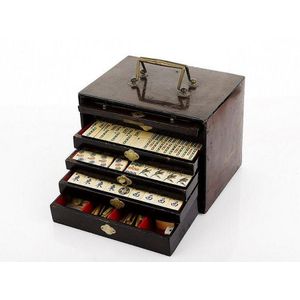Bauhaus Chess Set by Josef Hartwig for Naef
You must be a subscriber, and be logged in to view price and dealer details.
Subscribe Now to view actual auction price for this item
When you subscribe, you have the option of setting the currency in which to display prices to $Au, $US, $NZ or Stg.
- Bauhaus - Bauhaus refers to design concepts that originated at the German art school of the same name that was founded in 1919 by architect Walter Gropius. The school was based on the principles of modernist design, and sought to bridge the gap between art and industry by teaching students how to create functional and aesthetically pleasing designs for mass production.
Bauhaus had a significant impact on modern design and architecture, and is widely considered to be one of the most influential art schools of the 20th century. The school's approach to design emphasized simplicity, functionality, and the use of new materials and technologies. Bauhaus designers sought to create clean, uncluttered designs that were free from unnecessary ornamentation.
Bauhaus had a strong influence on a wide range of artistic fields, including architecture, furniture design, typography, and graphic design. Some of the most iconic examples of Bauhaus design include the Barcelona Chair by Mies van der Rohe, the Bauhaus Building in Dessau by Walter Gropius, and the typography of Herbert Bayer.
Bauhaus was active from 1919 until 1933, when it was forced to close by the Nazi government. However, the school's ideas and principles continue to be influential in design and art to this day. - Maple - Maple, native to North America, is a dense heavy timber from light to yellow-brown in colour. It has very little distincive graining unless it is one of the variants such as birds-eye maple or burr maple, so was not used extensively for furniture in 18th and 19th century, where cabinetmakers and designers preferred timbers with more distinctive features such as mahogany, walnut, rosewood and oak.
Birds-eye maple has a seres of small spots linked by undulating lines in the grain, is highly sough and is used as a decorative veneer. Burr maple has larger and irregular grain swirls than birds-eye maple.
This item has been included into following indexes:
Visually similar items

Captain James Davis, Book box, Tasmanian specimen wood, 19th century, Captain Davis was recognized as one of Tasmania's finest whaler's in the 19th century, Davis accompanied Sir Douglas Mawson on The Aurora as a whale expert on Mawson's Antarctic scientif

Mahjong set, comprising 144 tiles, a Collection of counters, dice and spare tiles, in original wooden box with each side depicting finely painted traditional scenes, together with a separate box of mother of pearl Mahjong tiles and counters, 18.5 x 24 x 18

A rare Victorian fitted mahogany games box, the hinged lid and double opening front revealing a fitted interior with shelves, containing red stained and white bone chess set, cribbage board, draught set, bone domino set, lead horses, cards etc. 33 cm x 22

A Victorian mahogany games box including bone and ebony dominos, chess, cards, draughts, backgammon, croquet, horse racing etc. Provenance: George Lansell Collection Bendigo from the Fortuna mansion, by direct family descent. 24 cm high, 27 cm deep, 39 cm
